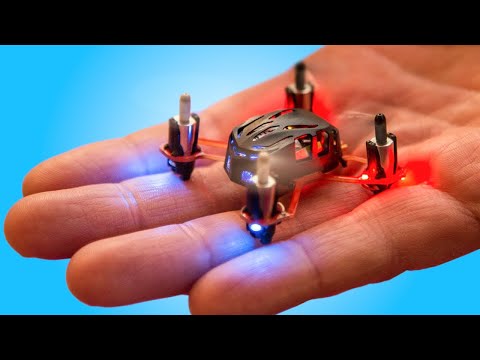The Rise of Drone Edge Technology
Drone edge technology processes data on drones themselves, revolutionizing industries with real-time analysis. Advantages include efficiency, autonomy, and cost savings. Future developments include swarming and AI integration. Challenges involve connectivity, privacy, and regulations.
Drones have rapidly advanced in recent years, and one of the most exciting developments is the emergence of drone edge technology. With the ability to process data on the drone itself, this technology is revolutionizing various industries.
Drone edge technology enables real-time data analysis and decision-making at the source, eliminating the need for transferring data to a centralized server. This has numerous advantages, including reduced latency and increased efficiency in critical operations.
In the agriculture sector, drones equipped with edge technology can assess crop health, identify pests, and optimize irrigation in real-time. This enables farmers to make timely interventions and maximize yields.
Similarly, in the construction industry, drones with edge capabilities can perform on-site inspections, monitor safety compliance, and detect structural issues promptly. This streamlines the construction process and improves overall project management.
Drone edge technology also plays a vital role in public safety and disaster management. Drones equipped with advanced sensors can quickly assess emergency situations, gather crucial data, and provide immediate insights to first responders. This enhances situational awareness and aids in swift decision-making.
Furthermore, the entertainment industry has embraced drone edge technology to capture stunning aerial shots in real-time. This allows filmmakers and photographers to achieve dynamic perspectives without the need for extensive post-processing.
As the technology continues to evolve, drone edge applications will expand into new domains such as package delivery, infrastructure inspection, and environmental monitoring. The possibilities are vast, and the benefits are undeniable.
Introduction to Drone Edge Technology
Drone edge technology refers to the utilization of drones for data processing and analysis directly on the device, at the edge of the network. This emerging field offers significant advantages in terms of efficiency, real-time decision-making, and reduced data transmission requirements.
-
Enhanced Efficiency: By performing data processing on the drone itself, edge technology minimizes the need for transferring large volumes of data to a remote server for analysis. This leads to faster processing times and reduced latency, allowing for quicker insights and actions.
-
Real-Time Decision-Making: Drones equipped with edge technology can analyze data on the spot, enabling real-time decision-making capabilities. This is particularly useful in scenarios where immediate actions or responses are necessary, such as monitoring critical infrastructure or emergency response operations.
-
Reduced Data Transmission: Edge technology reduces the amount of data that needs to be transmitted from the drone to a central server. Only relevant or pre-processed data is sent, minimizing bandwidth requirements and lowering operational costs. This is especially beneficial in remote or bandwidth-constrained environments.
-
Improved Autonomy: Edge technology empowers drones to make independent decisions based on pre-defined algorithms and artificial intelligence capabilities. This autonomy enables drones to adapt to dynamic situations, enhancing their operational efficiency and flexibility.
-
Applications: The applications of drone edge technology are vast and diverse. It can be employed in fields such as agriculture, infrastructure inspection, search and rescue missions, surveillance, and environmental monitoring. In each case, the ability to process data at the edge enhances the overall effectiveness and timeliness of the operations.
-
Security and Privacy: Edge technology also offers advantages in terms of data security and privacy. As sensitive data remains on the drone, the risk of unauthorized access or data breaches during transmission is significantly reduced. This is particularly crucial when handling confidential or sensitive information.
Advantages and Benefits
-
Enhanced Efficiency: Drones equipped with advanced sensors and imaging technologies enable quick and accurate data collection, increasing operational efficiency.
-
Cost Savings: Drones eliminate the need for manual labor and expensive equipment, leading to significant cost savings in various sectors, such as agriculture, construction, and infrastructure inspection.
-
Safety Improvements: Drones can be deployed in hazardous or hard-to-reach areas, reducing the risks associated with human intervention. They are ideal for tasks such as search and rescue operations or inspecting dangerous structures.
-
Real-time Monitoring: With live video streaming capabilities, drones provide real-time monitoring of critical areas, helping in surveillance, crowd control, and disaster response.
-
Time Optimization: Drones can cover large areas quickly, reducing the time required for tasks like aerial mapping, monitoring crop growth, or assessing damage after natural disasters.
-
Environmental Impact: Drones are environmentally friendly, as they minimize the use of traditional vehicles and reduce carbon emissions.
-
Accessibility: Drones can access remote or inaccessible locations, allowing for inspections of pipelines, power lines, or hard-to-reach infrastructure.
-
Precision Agriculture: Drones equipped with sensors and cameras can collect data on soil quality, crop health, and irrigation needs, enabling farmers to optimize resources and improve yields.
-
Rapid Data Acquisition: Drones equipped with high-resolution cameras or LiDAR technology can quickly capture detailed imagery or generate accurate 3D maps for urban planning, construction, and land surveying.
-
Innovation and Research: Drones open up new possibilities for scientific research, wildlife monitoring, and environmental studies by providing a unique aerial perspective.
-
Improved Documentation: Drones can capture high-resolution images and videos, assisting in documentation for insurance claims, property assessments, or site progress reports.
-
Flexibility and Scalability: Drones can be easily deployed and scaled to suit specific requirements, making them adaptable to a wide range of industries and applications.
Applications of Drone Edge Technology
Drone Edge Technology is revolutionizing various industries with its versatility and efficiency. – In agriculture, drones equipped with edge computing capabilities aid in crop monitoring, optimizing irrigation, and assessing soil health. – In disaster management, edge-enabled drones swiftly collect data in remote areas, assisting rescue missions and damage assessments. – The construction industry benefits from drones with edge computing by streamlining surveying tasks and ensuring site safety. – Environmental researchers use drones to monitor ecosystems, collect data on wildlife, and track climate change effects. – Drones equipped with edge technology facilitate faster delivery services for e-commerce and medical supplies, particularly in hard-to-reach locations. – In filmmaking and media production, drones offer unique aerial shots combined with real-time data processing. – Edge-enabled drones play a vital role in monitoring critical infrastructure like power lines, bridges, and pipelines. – They enhance security by performing surveillance, face recognition, and perimeter patrols. – Edge computing empowers drones in remote exploration, helping in mapping, mineral exploration, and archaeological surveys. – In the healthcare industry, drones with edge capabilities support emergency response and medical supply delivery during disasters. – Edge technology enables drone swarms to collaborate efficiently, enhancing search and rescue missions. – Drones equipped with edge computing are used in monitoring traffic flow and assessing road conditions for transportation planning. – The insurance industry benefits from edge-enabled drones in expediting claim assessments and damage evaluations. – Drones equipped with AI and edge computing perform tasks like wildlife conservation, planting trees, and monitoring deforestation. – They facilitate 3D modeling of buildings and landscapes for urban planning and architectural purposes. – Drones with edge technology are employed in monitoring and inspecting offshore installations in the energy sector. – In the telecommunications industry, edge computing on drones enhances network coverage in remote areas. – Edge-enabled drones support precision agriculture by providing real-time data for targeted pesticide application. – In law enforcement, drones equipped with edge computing assist in crowd monitoring and disaster response. – The mining industry utilizes edge-enabled drones for surveying, safety inspections, and asset management. – Drones with edge technology enable autonomous flights, enhancing their operational efficiency and safety. – They aid in detecting forest fires and deliver critical information to firefighting teams for prompt action. – Edge computing on drones supports scientific research by collecting data for climate and atmospheric studies. – In conclusion, drone edge technology’s diverse applications continue to reshape industries and drive innovation globally.
Challenges and Considerations
- Connectivity – Maintaining a stable connection between drones and edge devices is crucial for real-time data processing.
- Edge Infrastructure – Ensuring sufficient computing power at the edge for complex drone applications is challenging.
- Energy Constraints – Drones have limited battery life, necessitating energy-efficient edge algorithms and hardware.
- Data Security – Safeguarding data transmitted and processed at the edge against potential cyber threats is paramount.
- Latency – Minimizing latency is vital for time-sensitive applications like drone surveillance or delivery.
- Edge-Cloud Integration – Seamlessly integrating drone-generated data with cloud platforms poses integration complexities.
- Environmental Factors – External conditions like weather and interference can hinder edge communications.
- Edge Device Placement – Strategically positioning edge devices to cover vast drone operational areas requires planning.
- Data Prioritization – Prioritizing essential data for immediate processing at the edge can optimize bandwidth utilization.
- Redundancy – Implementing backup systems at the edge to avoid single points of failure is critical.
- Regulation and Compliance – Complying with evolving drone and edge computing regulations is a challenge.
- Edge Device Maintenance – Ensuring regular maintenance of edge devices to prevent downtime is vital.
- Edge Algorithm Optimization – Developing efficient algorithms for resource-constrained edge devices is complex.
- Interoperability – Ensuring seamless communication between different drone and edge device manufacturers is a concern.
- Edge Analytics – Performing real-time analytics at the edge requires overcoming computational limitations.
- Human Intervention – Determining when to involve human operators in critical drone-edge decisions poses challenges.
- Privacy Concerns – Addressing privacy concerns related to drone data collection and edge processing is essential.
- Edge Scalability – Scaling edge infrastructure to accommodate a growing drone fleet necessitates careful planning.
Future Outlook and Conclusion
The future of Drone Edge technology appears promising, with numerous advancements and applications on the horizon. First and foremost, we anticipate continued improvements in drone hardware, including enhanced battery life, payload capacity, and range. These upgrades will enable drones to operate for extended periods and carry out more complex tasks efficiently.
Furthermore, there will likely be substantial progress in drone swarming capabilities, enabling multiple drones to collaborate seamlessly and accomplish tasks that would be impossible for a single drone. Swarms could be used for search and rescue missions, environmental monitoring, and even package delivery, revolutionizing various industries.
One area with great potential is the integration of artificial intelligence (AI) and machine learning (ML) algorithms into drone systems. AI-powered drones could autonomously navigate complex environments, adapt to changing conditions, and even make real-time decisions. This will make drones more efficient, safer, and reduce the burden on human operators.
In the agricultural sector, drones equipped with advanced sensors and imaging technology could continue to transform farming practices. They can provide valuable data on crop health, water usage, and yield predictions, aiding farmers in making informed decisions and optimizing their operations.
Additionally, the role of drones in infrastructure inspection and maintenance is expected to expand. With their ability to access hard-to-reach areas, drones can help detect structural issues in bridges, buildings, and power lines, enhancing safety and reducing costs.
However, with these opportunities come challenges. The regulatory landscape must keep up with the rapid pace of drone innovation. Striking a balance between fostering growth and ensuring public safety will be crucial. Additionally, concerns about privacy and security must be addressed to gain public trust and acceptance.



